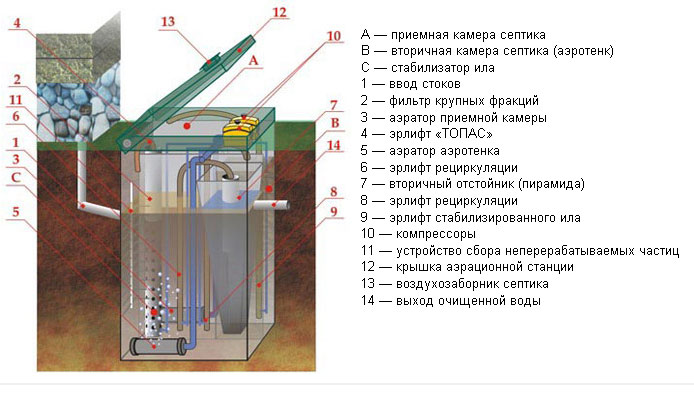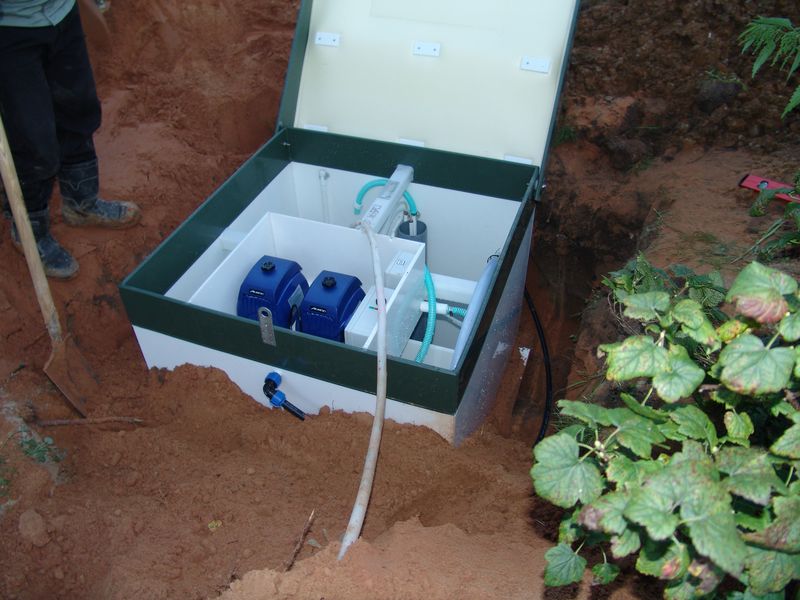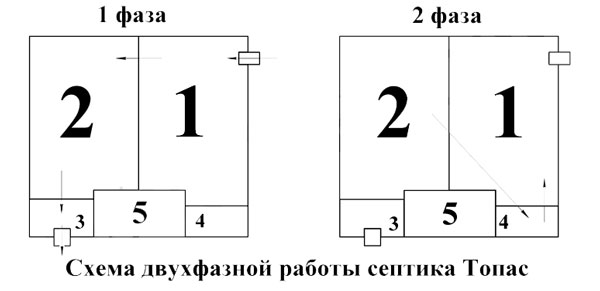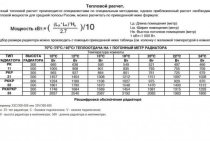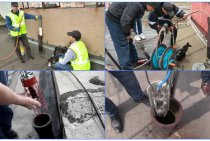Design features of a septic tank
The device of the septic tank model Topas
The Topas treatment system is a monoblock structure designed for any type of soil. It has a polypropylene body.
The main difference is the method of wastewater treatment, in the Topas septic tank this is due to anaerobic bacteria, which require oxygen for their vital activity. The use of such a sewer does not require maintenance.
Unlike other similar devices, its care consists in periodically checking the correct operation. But it is worth remembering that at one time you can drain the volume of water not exceeding that indicated in the passport.
Autonomous sewerage using a Topas septic tank can be used in any climatic zones, its operation scheme does not depend on temperature and other indicators. Installation of equipment for a private house does not require concreting a site for it. When installing, you can limit yourself to a sand cushion.
Topas 5
The compact dimensions of the septic tank allow it to be placed in a pit measuring 1.5x1.5 m. Wastewater treatment with Topas brand equipment reaches 98% and at the outlet complies with existing standards.
The device of the Topas septic tank assumes an absolutely sealed body, made of a material resistant to aggressive environments, which makes its use environmentally safe. In addition, during its operation it is not necessary to call a sewage truck. Maintenance consists in pumping out sludge from the system, no more than once a quarter. Moreover, it can be used as fertilizer in the garden.
Mounting the device
Now let's talk about how to install a Topas septic tank. There is nothing complicated in this and everything can be done independently. The only thing that will have to invite assistants when lowering the device into the pit.
The installation of a Topas septic tank begins with determining a suitable location. Here you need to consider the following facts:
- The location should be close to home. According to the attached instructions, the minimum distance from the installation site of the Topas septic tank to the main building is five meters.
- When choosing a place, try to ensure that the sewer pipes, leaving the house, go straight to the septic tank. Excessive bends and turns can contribute to the formation of blockages, which means additional cleaning work.
- There should be no heavy vegetation around the installation site. The roots of trees and large bushes can damage the body of the septic tank.
- It is also worth knowing the depth of soil freezing in your area. This will determine at what distance from the surface the sewer pipes and the cleaning device itself can be laid.
- If groundwater is close to the surface, then the bottom of the pit must be reinforced with a concrete slab or sand-cement screed.
If we have decided on a place, then we proceed to dig a pit. Its dimensions will depend on the chosen model of the Topas septic tank. As a rule, such devices are relatively compact, so digging a pit can be done manually.
When carrying out earthworks, one should not forget about the necessary gaps between the walls of the pit and the body of the septic tank. They are needed for further filling the device with soil. Such gaps should be at least 20 cm. Also, the depth of the pit should be made larger for the construction of a sand cushion. If groundwater comes close to the surface, then the depth is made taking into account the installation of a concrete slab or sand-cement screed.
After the foundation pit is ready, its foundation is made. The sand cushion should be at least 15 cm. Also try to make the top of the septic tank protrude above the ground. This is necessary so that the spring meltwater does not flood the equipment of the device.
After equipping the base, lower the septic tank into the pit. This can be done manually with the assistance of an assistant. To do this, use the cables threaded through special holes in the stiffeners of the structure.
The next step is to connect the septic tank to communications. The first step is to connect the sewer pipe. First you need to dig trenches for pipes and lay the pipeline itself.
When laying sewer pipes, do not forget about the slope. It should go from the house to the septic tank and be 1-2 cm per linear meter. The depth of laying pipes will depend on the depth of soil freezing. As a rule, it is from 70 to 80 cm.
Before starting work on connecting the septic tank, it is necessary to level it with a building level. Only in a strictly horizontal position will the device work more efficiently.
To connect the sewer pipe to the septic tank, a hole of the required diameter is made in the housing. Everything must be done according to the attached instructions. Then a pipe is welded to the hole, it is advisable to do this using a polypropylene cord and a building hair dryer. After the connection has cooled down, a sewer pipe is inserted into the pipe.
Now it's time to connect the electrical cable. It must be carried out from the shield in the house with a connection to a separate machine. The cable itself is laid in a corrugated pipe and can be placed in the same trench as the sewer pipes. Electricity is connected to a special hole with stamps on the body of the septic tank.
After connecting the power supply and sewer pipes, the septic tank is covered with soil. This must be done gradually, in layers of 15–20 cm. At the same time, water is poured into the container to equalize the pressure. The water level should be slightly above the fill level. So, gradually, layer by layer, the septic tank is completely covered with soil.
If the level of soil freezing is quite large, it is possible to insulate the septic tank. This is done before backfilling with soil. As a heater, you can use any heat-insulating material intended for laying in the ground.
This completes the installation of the Topas septic tank. If everything is done correctly and taking into account the recommendations set out in the instructions for the product, the device will last for decades.
Septic tank operation
Topas septic tank can serve up to fifty years, but subject to proper installation and operation. The most important thing is to follow the recommendations on substances allowed for discharge into the sewer. If this is not done, then the colony of microorganisms will die. This means that wastewater treatment will not occur.
In addition, the maintenance of the Topas septic tank consists in carrying out periodic events. Namely:
- Clean the deep filter monthly.
- The membrane needs to be replaced every two years.
- Once every four years, pump out the accumulated sludge. This can be done with a deep well pump. Silt is an excellent fertilizer, so it can be pumped directly to the garden.
- Once every ten years, carry out a complete cleaning of the septic tank with the replacement of the aerator.
If you strictly follow all the recommendations of the manufacturer, then the septic tank will serve for many decades.
A little about the product itself
Topas series septic tanks have four compartments assembled into a single body. This design makes it easier to install the unit. Each compartment performs its specific function of wastewater treatment. The internal structure can be seen by opening the lid. If you are interested, you can see the detailed.
All drains from the sewer pipes enter the first chamber. Large fractions are cleaned in it, they simply settle to the bottom. When filling the chamber to a certain level, the installed float turns on the automation. After that, the pump begins to pump liquid into the second chamber.
The second compartment plays the role of an aeration tank. Bacteria live, multiply and feed here.They break down large fractions of pollutants (which passed through the first chamber) and destroy organic matter.
In this compartment, silt, which forms at the bottom, plays an important role. It retains water and allows bacteria to better cope with their tasks. To make the cleaning process more active, the compressor constantly supplies fresh air, while mixing the drains and sludge.
The liquid then enters the third section. Its principle of operation is very simple, already treated effluents go through a kind of pyramid. Here the purified liquid is separated from the sludge residues. The result is almost pure water. Large sludge settles on the bottom, while smaller and fresher returns to the second chamber for further work. In the last, fourth chamber, the final purification of water takes place.
Topas series septic tanks must work constantly. If there is a big break in the flow of sewage, then the efficiency of work will drop sharply. The fact is that bacteria need to constantly eat. If there is no sewage, the microorganisms will have nothing to eat, and they will simply die. Therefore, Topas septic tanks are best installed in houses with permanent residents.
When operating the system, the reset rules must be observed. So, they should not get into the sewer (so as not to harm the colonies of microorganisms or clog the insides of the device):
- sand and construction debris;
- rubber, polymer and other products that are not processed by microorganisms;
- oxidizing agents, drugs and substances containing chlorine;
- automotive oils;
- spoiled vegetables.
Everything else, including powder, soap, and detergents, can be poured into the sewer without fear.
How a septic tank works
The Topas septic tank performs a phased purification of sewage water, consistently and thoroughly freeing it from all kinds of contaminants. A special biomass, activated sludge, takes part in the purification process. It consists of various bacteria and microorganisms that decompose organic compounds. The main part of these microorganisms lives and multiplies only in the presence of oxygen, therefore special conditions are created in the Topas septic tank, namely, oxygen is periodically pumped with the help of compressors.
Aerobic microorganisms enter the Topas septic tank along with wastewater and, under favorable conditions, begin to form entire colonies that use organic compounds for nutrition. Anaerobic bacteria also take part in wastewater treatment, which partially decompose organic matter immediately in the receiving chamber where wastewater enters, as well as in the chamber where the final stage of wastewater treatment and sedimentation of waste sludge takes place.
The Topas septic tank treats wastewater in two phases.
The first phase starts the septic tank to work on the purification of wastewater, which enters from the dwelling through the inlet sewer pipe into the receiving chamber (1), where they accumulate to a certain level. During this time, large fractions precipitate and their initial decomposition by anaerobic bacteria occurs.
how a septic tank works
As soon as the wastewater in the receiving chamber (1) reaches the set level, a float sensor is activated, which starts the first compressor of the second chamber (2) of the Topas septic tank, where wastewater from the receiving chamber is pumped using an airlift. The compressor pumps oxygen and literally enriches the polluted water with it.
Such fine-bubble aeration grinds organic pollution, oxidizes them, and aerobic bacteria begin to feed on them. As a result, activated sludge is formed. From the second chamber (2), purified water with activated sludge is pumped into the sump, where the waste sludge settles to the bottom, and clean settled water leaves the septic tank by gravity or is pumped out forcibly using a pump.
The first phase of cleaning continues until the wastewater in the receiving chamber again drops to a certain level, then the sensor is triggered again, which will start the second compressor and the second phase will begin.
The second phase of treatment is, first of all, the enrichment of waste water in the receiving chamber with oxygen, and the movement of activated sludge there for a new cycle of wastewater treatment. This phase continues until the level of incoming effluents rises again in the receiving chamber and the sensor trips.
Thus, the operation of the sensor allows you to switch compressors and alternate the first and second phases of wastewater treatment. In fact, the wastewater undergoes a double deep cleaning with the help of aerobic bacteria, which are also assisted by anaerobic bacteria in the last stage of water purification, when the waste sludge is observed.
The Topas septic tank and the principle of operation of the Topas septic tank allows you to purify sewer water from the most complex and dangerous organic compounds, so it is indispensable when creating a local sewerage system in modern suburban real estate.
